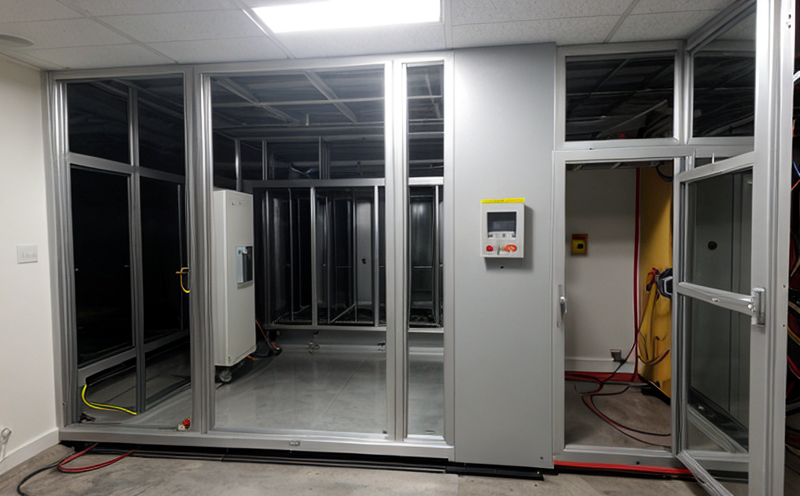Controlled Environment Ventilation Efficiency Testing
In today’s increasingly stringent environmental regulations and growing awareness of energy efficiency in buildings, the importance of accurately testing ventilation systems cannot be overstated. Controlled environment ventilation efficiency testing is a critical component that ensures HVAC (Heating, Ventilation, and Air Conditioning) systems function optimally while meeting strict regulatory standards.
By simulating real-world conditions within controlled environments, this testing method provides precise measurement of the performance parameters of ventilation equipment. This includes air flow rates, pressure differentials, energy consumption, and overall efficiency. The purpose is to validate that the system operates as designed under various operating conditions, which directly impacts the building’s operational costs and occupant comfort.
Controlled environment testing allows for a comprehensive evaluation of the system's performance across multiple dimensions:
- Air Flow Rates: Measuring the volume of air passing through the ventilation system to ensure it meets design specifications. Variations in flow rates can lead to inadequate air distribution and increased energy consumption.
- Pressure Differentials: Monitoring the pressure differences between different zones within a building to prevent uncontrolled air leakage, which is crucial for maintaining HVAC efficiency and occupant comfort.
- Energy Consumption: Evaluating how much energy the system consumes during operation. This helps in identifying areas where improvements can be made to reduce operational costs without sacrificing performance.
The testing process involves setting up a controlled environment that mimics actual operating conditions, which allows for accurate and reliable measurement of these parameters. This is typically done using specialized equipment such as flow meters, differential pressure gauges, and energy meters. The data collected during the test is then analyzed to determine if the system meets the required performance criteria.
Controlled environment ventilation efficiency testing plays a crucial role in ensuring compliance with international standards like ISO 13790:2016, which provides guidelines for measuring and expressing the energy performance of buildings. By adhering to these standards, building owners and operators can ensure that their HVAC systems are operating efficiently and cost-effectively.
| Parameter | Description | Measurement Method |
|---|---|---|
| Air Flow Rates | The volume of air passing through the ventilation system. | Using flow meters and pressure sensors to measure airflow at various points in the system. |
| Pressure Differentials | Differences in pressure between different zones within a building. | Measuring using differential pressure gauges placed strategically throughout the ventilation network. |
| Energy Consumption | The amount of energy consumed by the system during operation. | Monitoring with energy meters that capture consumption data over a specified period. |
Why It Matters
The importance of controlled environment ventilation efficiency testing cannot be overstated, especially in the context of HVAC systems. Properly functioning ventilation ensures not only occupant comfort but also contributes significantly to energy savings and environmental sustainability.
- Economic Benefits: By optimizing system performance, businesses can reduce their operational costs, which translates into significant financial savings over time.
- Environmental Impact: Efficient ventilation systems contribute to lower greenhouse gas emissions by reducing energy consumption. This aligns with global efforts towards sustainability and climate change mitigation.
- Occupant Comfort: Ensuring that the system operates optimally enhances indoor air quality, which is critical for maintaining occupant health and well-being.
Compliance with relevant standards and regulations is essential to ensure that HVAC systems meet not only current performance levels but also future requirements. This testing method provides a robust framework for continuous improvement, supporting ongoing efforts towards sustainability and efficiency.
Scope and Methodology
The scope of controlled environment ventilation efficiency testing is broad and encompasses various aspects of the HVAC system. The methodology typically includes several key steps:
- Preparation: Setting up the controlled environment to simulate real-world conditions, including temperature, humidity levels, and air flow rates.
- Data Collection: Using specialized instruments to measure critical parameters such as air flow rates, pressure differentials, and energy consumption. This data is collected over a specified period to ensure accuracy.
- Analysis: Analyzing the collected data to determine if the system meets the required performance criteria. This analysis is crucial for identifying any areas where improvements are needed.
- Reporting: Compiling a detailed report that includes all test results and recommendations for improving system performance, if necessary.
The testing process is designed to be comprehensive and objective, ensuring that the data collected is accurate and reliable. This allows for informed decision-making regarding system upgrades or modifications needed to meet current and future regulatory requirements.
Use Cases and Application Examples
- New Construction: Ensuring that newly installed HVAC systems comply with design specifications before they are put into operation. This helps prevent costly mistakes and ensures that the system operates efficiently from day one.
- Pre-Commissioning Audits: Identifying potential issues in existing systems before full-scale commissioning is carried out, which can save time and resources by addressing problems early on.
- Ongoing Maintenance: Monitoring the performance of HVAC systems over time to ensure that they continue to operate efficiently. This helps in identifying any signs of wear and tear or potential failures before they become critical issues.
The following table provides a detailed overview of some common use cases for controlled environment ventilation efficiency testing:
| Use Case | Description |
|---|---|
| New Construction | Ensuring that newly installed HVAC systems comply with design specifications. |
| Pre-Commissioning Audits | Identifying potential issues in existing systems before full-scale commissioning is carried out. |
| Ongoing Maintenance | Monitoring the performance of HVAC systems over time to ensure continued efficiency. |





